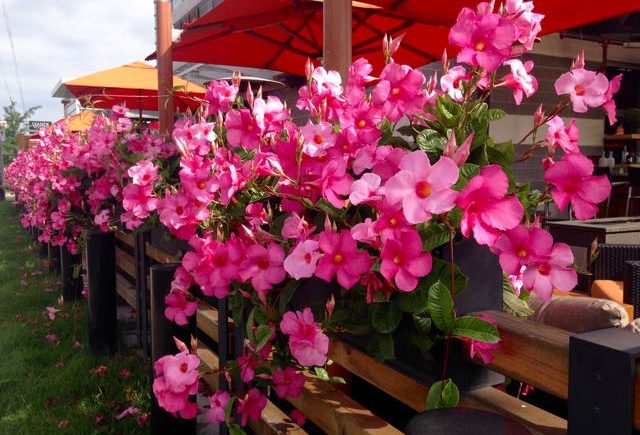| Who’d bother planting geraniums (Pelargonium) in planter boxes, when you could get a show-stopping display like this one at a Leaside pub. These are Mandevilla. And, in fact, so are dipladenias. |
Not till after I got a Dipladenia ‘Rio’ to trial, from Toronto Fling sponsor Fernlea, did I learn the difference between Dipladenia and Mandevilla. There isn’t one! They’re all Mandevilla now, according to the World Checklist of Selected Plant Families. Oh, you darned taxonomists. Bless your hearts.
For some time, I’ve meant to write about my success with the hot pink ‘Rio’ Dipladenia (Dipladenia is a synonym for Mandevilla sanderi). Then, the other day, the above display of one of its big Mandevilla cousins halted me in my tracks. Wow. Makes typical planter combos look pretty paltry.
But given that my ‘Rio’ had to put up with one-fourth of the sunshine, compared with these, I’m impressed, and would grow it again. For a showy flower, it’s remarkably easy care. Heat? Drought? No problem. They’re also said to stand up to cold, but we haven’t put that to the test this summer. They only thing they don’t like is soggy feet – because they grow from a tuber. Who knew?
 |
| And here’s my Dipladenia ‘Rio’, now reclassed as Mandevilla sanderi. In general terms, dipladenias are shrubbier and more compact than the plant people differentiate as Mandevilla. They also have smaller, pointier leaves, without the crinkles. (Don’t know why there’s resistance to the name change, even from experienced garden writers and the industry. Oh well.) They say my dipladenias can be over-wintered indoors. But given my record with houseplants, I’ll take the advice of Mr. Subjunctive – my resource for all things houseplanty – and resist. See Note 4 on his post about a surprising plant relative. |
So in a nutshell: Mandevillas are big and vining; dipladenias are small and shrubby, and don’t begin to produce vining shoots until late in the season (mine are doing that now). But they’re both great plants that we should use more often. And they’re both Mandevilla. So say we all. I guess.






6 comments
I am loving the Dipladenia too. I planted it in a concrete urn & it's still alive, which is quite the feat considering my brown thumb when it comes to potted plants, both inside and out. Since it's a tuber, does this mean that I can dig it up over the winter and replant it come spring? Margaret…who is in the land of mouse ears right now & can't recall her Google info 🙂
I'm not certain, but I'm guessing it's probably best not to try starting from scratch with a tuber — you might not get a large enough plant for flowering. I had two larger Dipladenia (a friend gave me theirs) and one small one. The smaller one didn't start flowering till weeks after the larger ones. You can cut it back to over-winter it. The "even experienced gardeners" link above has over-wintering instructions.
I grew a red type that vines, so I'd call it a Mandevilla! So tough,they really can stand lots of neglect, (a requisite for my planters it seems). I'd really love to try the shrubbier sort.
Ilona, if only you lived closer, I could give you mine!
Nice looking plant. Is there some way to impose a moratorium on name changes by taxonomists?
Good luck with that, Jason, but if you succeed, let me know!